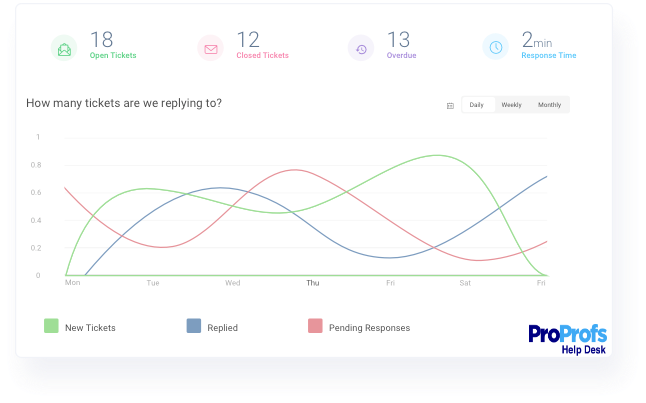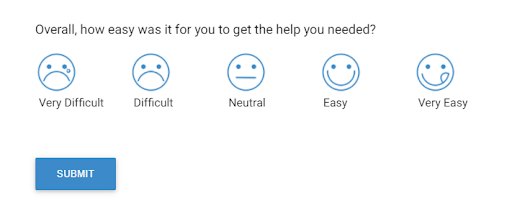The amount of data that we are generating can blow anyone’s mind.
Every single day, quintillion bytes of data is generated. To get things into perspective, quintillion has 18 ZEROS. (still proud of your phone memory?)
Modern customer service teams are no different. They have become data factories that are pumping out information at a breakneck pace. From customer feedback information to call recordings worth thousands of hours, the data at hand is gigantic.
Is your customer service department lost in a sea of data? How do you possibly make sense out of all these numbers?
Customer service analytics can help you segregate ‘information’ from junk data. With the help of customer support software, you will have a clear idea about what’s working well and how you can further improve your service operations. Moreover, you will be able to uncover valuable insights into customer expectations and give a shot at predicting your customer’s future behavior. Sounds interesting?
Then dive right into this blog that explores the multiple use cases of customer service analytics and the metrics that your business must be tracking today.
What Is Customer Service Analytics?
“Customer service analytics is the process of collecting and analyzing all the information that is generated by your customer service team.”
Imagine this.
You design a kick-ass survey and share it among your target audience. A good fraction of customers respond and share their inputs. Now, what do you do of this collected information? How do you present it in a sophisticated manner to gain valuable insights?
This is where customer service analytics come into the picture and help you put together all the jumbled pieces of information.
Customer service data leads to better decision making. You can present all the collected feedback using graphs and bars and unravel answers to important questions like- how many customers are satisfied with our service? What major issues customers are encountering while reaching out to us? And so on.
Customer Service Analytics Use Cases
“Data will talk to you if you are willing to listen.”- Jim Bergeson
Let’s look at some important areas where customer service analytics can prove to be a game-changer.
1. Discover Customer Pain Points
Whenever an issue arises, customers have one place to go- the customer service department. Therefore, it’s no surprise that your customer service professionals understand customer’s pain points better than anyone else in the business.
Behind every unhappy customer is an important pain point that a business failed to solve.
With the help of customer service analytics, you can not only discover pain points but also find ways to position your company or product as a solution to common customer problems. You can even check the success of your customer service channels.
For instance, if the bounce rate on your self-service portal or Knowledge Base is high, it’s a clear indicator that the content is not helpful for your customers.
If you want your product or service to remain in trend, you need to identify and eliminate every single pain point.
2. Analyze Customer Feedback & Suggestions
In the business town, entrepreneurs are ready to go the extra mile to capture customer feedback. But what happens to all the feedback and suggestions? Do businesses really care to act upon them?
According to a Microsoft Report, 37% of Americans believe that brands do not take action on the feedback provided by them.
Collecting customer feedback is not enough; you need to conduct a thorough analysis to get to your customers’ pulse. Customer service analysis can help you transform raw feedback into meaningful data that can lay out the roadmap for your business.
After an in-depth analysis of customer feedback, your business can unravel important answers. Your support team would know how happy customers are with the promptness of their service. Similarly, your product team would know what all major improvements can be made to the beta version of a mobile app.
Read Also: 5 Ways to Collect Customer Feedback
3. Measure Performance & Reward Employees
Whether it’s your service manager who has decades of experience, or a new intern who has just joined your department, everyone should be motivated to perform.
Customer service analytics help you track key performance indicators (KPIs) and measure performance against service level agreements (SLAs). For instance, you can track the average response time of your agents and see who is exceeding expectations and who needs to pull up their socks and improve.

“To win in the marketplace, you must first win in the workplace.” – Doug Conant
If customer service analysis points to positive results, investigate further, and see who have been the top contributors to this successful feat. Also, there is no point in hiding performance data, make sure your KPI dashboard is visible to everyone so that they have the right idea about performance expectations.
4. Make Informed Decisions & Reduce Costs
The ability to make decisions that are backed by data is the cornerstone of a well-performing business. Why is decision making important in customer service?
Customer service analytics can not only point to past performance but also show you a reflection of the future. For instance, after proper analysis, your business can identify the support channels that are most preferred by customers to approach your business. So, if a majority of customers prefer instant resolution, focusing on live chat will be the right decision.
The future of customer service will be determined by data-driven decision making.
Reducing customer service costs does not necessarily mean to reduce your team size or invest in low-quality hardware. With proper planning, you can achieve the highest quality of services with the lowest costs possible.
For instance, if analytics point to the fact that many customers reach out to your business for common queries. You can create a dedicated knowledge base to reduce support tickets as well as costs.
Customer Service Metrics You Need to Track Today
1. Customer Service Metrics for Performance
- Average Response Time
The average response time denotes the average time taken by your agents to respond to customer queries or complaints. Customers demand immediate resolutions to their problems. Therefore, the goal should be to significantly reduce the average response time and share faster responses irrespective of the channel.
- First Contact Resolution
First contact resolution (FCR) is an important customer service metric that reflects your agents’ ability to resolve customer problems on the first attempt. When there is no need for customers to keep contacting you for that same issue, again and again, customer happiness is bound to go up.
- Ticket Volume
By understanding the total volume of tickets (issues or requests) coming into your business and their nature, you can make important decisions. For instance, you can decide the manpower you would need to manage a rising ticket volume and create appropriate work schedules such that your agents are always available.
2. Customer Service Metrics for Customer Experience
- Customer Satisfaction Score
Successful businesses are always measuring how satisfied customers are with their products or services. The CSAT score is an important metric that will help you determine the quality of customer service experiences. You can create a CSAT survey in minutes using survey software and share it with your target audience. This is what it looks like-

- Net Promoter Score
Net Promoter Score (NPS) strives to measure customer loyalty by asking customers how likely they are to recommend your product or service to others. Customers have to respond on a scale of 0-10 (10 depicting the highest loyalty). For instance, to evaluate the quality of your service, you can share an NPS survey soon after the termination of a successful support call.

- Customer Effort Score
Customer Effort Score (CES) helps you measure how much effort was required by customers to get their issues resolved. CES is an important customer service metric that can highlight the quality of experience a customer had during a support interaction. In a CES survey, customers can rank their experience on a 5 or 7 point scale (ranging from ‘Very Difficult’ to ‘Very Easy’).

Read Also: What Is a Good Customer Effort Score
Customer Service Tools for In-depth Analysis
1. ProProfs Help Desk- Ticket Tracking

ProProfs Help Desk is a popular customer service tool that is hosted on a reliable cloud platform- IBM and offers anytime, anywhere access. With its easy-to-use interface, customer service managers can get hold of important reports and insights in just a few clicks. Let’s quickly see what more you can achieve with this tool.
- Track the complete ticket lifecycle, from the moment a ticket is registered through to its resolution
- With smart reports, you can view the Ticket Volume, Open Tickets, Average First Response Time, and more
- You can also analyze the Rated Tickets (tickets that receive a rating from customers once they have been resolved)
- You can share CSAT, NPS, CES surveys to capture crucial customer feedback
2. Qualaroo – Customer Feedback

Qualaroo is a leading user feedback software that can help you capture valuable customer opinions in relation to your customer service operations. Qualaroo is powered by IBM WATSON, which helps you turn free-form text into organized information. This means that you can better analyze customer feedback by tracking the mood metrics and sentiments of the customer. When it comes to customer feedback research, this tool should be on your list.
- You view crucial information such as the total number of individual responses, the time and date of the survey, respondents’ IP address, and more
- You can sort customer responses by browser/operating system, or page (the webpage from which the survey was taken)
- For NPS surveys, responses are automatically segregated as promoters, detractors, and passives
3. SproutSocial- Social Media Monitoring
In the world of social media, every like, post, share, and comment matters. This is where SproutSocial can help you offer reliable customer service over the leading social media platforms. This social media management tool can help your business schedule posts through multiple profiles and engage with customers.
- Team members can assign tasks among themselves and collaborate to support customers
- A single customer message (Tweet, Facebook post, etc.) can be converted into a ticket and assigned to a relevant agent
- You can manage customer communications and get notified about relevant customer activities
- Access essential customer information from their social profiles to offer a personalized customer service experience
FREE. All Features. FOREVER!
Try our Forever FREE account with all premium features!
Measure Metrics. Improve Performance. Delight Customers
Customer service analytics offer rich insights into two crucial aspects- first, how customers perceive your customer service, and second, how well your team performs to meet the rising customer expectations.
Metrics like Average Response Time, First Contact Resolution, CSAT, etc. can help you gauge whether your business is on the right track to offer exceptional customer experiences. However, analyzing qualitative data is extremely important to understand the complete story behind these numbers.
Customer service data hides more than it reveals, and ProProfs Help Desk is here to help you make sense of all of it. With our intuitive customer service software, your business can measure the metrics that matter and offer delightful support every single day.
Want to Learn More? Here Is Our FAQ Section
Q1. How customer service analytics enhances the customer experience?
Customer service analytics can help you track customer-focussed KPIs such as CSAT, CES, and NPS. Once you have measured these metrics, you can look for ways to enhance the overall customer experience.
Q2. Do customer analytics techniques boost sales and service strategies?
Yes, customer analytics can boost sales as well as lead to better service strategies. With the right data at hand, you will be able to better understand your target consumer and create top-notch sales strategies. Similarly, better service strategies can be created by analyzing the performance of your agents.
Q3. What are the 3 most important aspects of customer service?
The three most important aspects of customer service are:
- Speed– How quickly you respond to customer requests or issues
- Proactiveness– How you anticipate problems even before your customers know they have them
- Personalization– How you add a personal touch to every customer service interaction
 Tips
Tips
We’d love to hear your tips & suggestions on this article!
FREE. All Features. FOREVER!
Try our Forever FREE account with all premium features!


 We'd love your feedback!
We'd love your feedback! Thanks for your feedback!
Thanks for your feedback!







